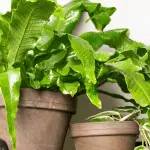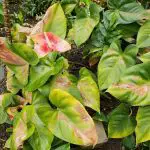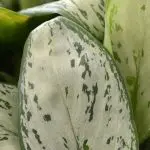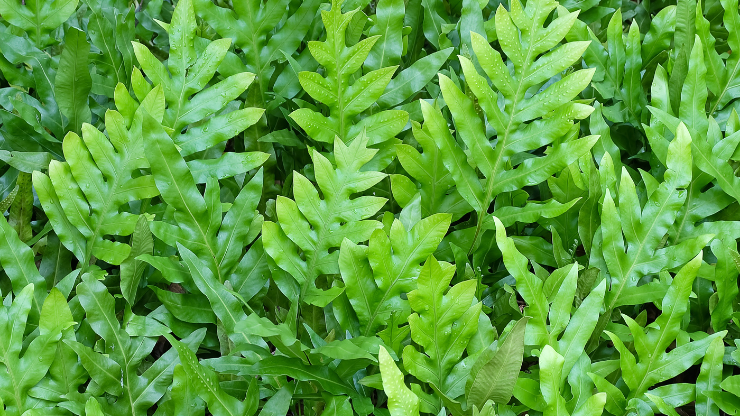
The kangaroo paw fern (Microsorum diversifolium or Polypodium diversifolium) is a relatively easy to care for houseplant once you know what it needs. If given adequate attention, it will thrive in almost any home. Browning leaves are a sign that something’s wrong.
So, why are your kangaroo paw fern leaves turning brown? This is almost always a sign of a dry or under-watered plant. This could be because it’s getting too much sunlight, not being watered enough, or is potted in poor soil. Let’s take a look at three easy ways to fix this problem.
Fix #1: Decrease Sunlight
Too much sunlight can cause dry soil (even if you’re watering regularly) which leads to browning leaves. Kangaroo paw fern cannot tolerate direct sunlight. It needs medium, indirect light to really thrive. If it’s getting too much sun, you may also notice curling fronds.
If you suspect too much light is your problem, move your fern to a place where it receives medium, indirect sunlight. Ideal locations include:
- A bright, north-facing window
- An east-facing window
- A few feet back from a west-facing window
- Or even further back from a south-facing window
Avoid placing kangaroo paw fern directly in a south-facing window. If this is the only place you have, hang gauzy curtains to filter the light and place at least three feet away from the glass. You can employ the same strategy with a west-facing window, placing at least two feet away.

Fix #2: Water Consistently
Inconsistent watering is another primary reason for kangaroo paw fern leaves turning brown. For the best results, never let the soil dry out completely. Keep it evenly moist, but never wet. If you live in a dry climate, this may mean watering more often.
How often should I water my kangaroo paw fern?
For plants that require consistently moist soil, water any time you touch the top of the soil and it feels dry. Until you get a feel for how often your individual plant needs watering, check it every day at the same time. As soon as the top of the soil no longer feels moist, it’s time to water.
This can be a delicate balance because you also don’t want to over-water. If the soil feels wet or soggy, or you notice standing water in the pot or on top of the soil, you are over-watering. See my post on how to tell if a plant is over-watered or under-watered for more guidance.
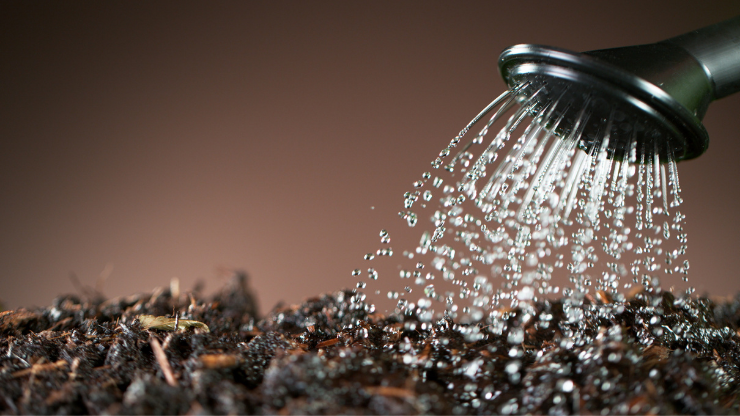
Here are some tips specific to kangaroo paw fern and how to tell if it needs water:
- Pay attention to the stiffness of the fronds.
- Upright, stiff fronds mean the plant is well-watered.
- Drooping fronds mean it’s time for a drink.
Keeping humidity levels from dropping too low near the plant can also help prevent the soil from drying out. Try placing a high-quality houseplant humidifier in the room, or place the plant on a humidity tray (a small tray filled with pebbles and water).
Fix #3: Pot Properly
Another reason your kangaroo paw fern leaves might be turning brown is poor quality potting soil and/or using the wrong type of pot.
If you have poor soil that doesn’t drain well or doesn’t retain moisture, your fern will not get the consistent moisture it needs. Likewise, if you’re using a pot that doesn’t accommodate the creeping rhizomes, you may also have a difficult time preventing leaves from browning.
Potting Soil
To keep the soil moist and well-drained – a necessity for kangaroo paw fern – choose a mix that helps retain moisture. Additives like coco coir, peat moss, and vermiculite help hold moisture in. You also want your soil to be nutrient-rich and breathable without being heavy.
In my experience, the best potting soil mixture for kangaroo paw fern is one that includes coco coir and perlite or vermiculite. I prefer coco coir over peat moss as it retains water better in the long-run. However, peat moss mixes are a bit less expensive and will work just as well.

Lately, I have been loving Wonder Soil for my ferns and other plants that need consistent moisture. It’s a coco coir-based soil with added amendments of worm castings, mycorrhizae, kelp, and perlite. It’s perfect for kangaroo paw fern and moisture-loving plants of all kinds.
Good, well-draining soil is necessary for growing ferns successfully indoors. No matter which one you choose, make sure it’s formulated for houseplants, contains beneficial additives like those listed above, and specifically says that it has good drainage.
Best Container
A wide pot is the best container for a kangaroo paw fern. This allows it to creep across the potting soil. A hanging basket is also a good choice, as the rhizomes will grow over the top and down the side of the container. The foliage will also cascade over the side in a beautiful display.
To help with moisture retention, plant kangaroo paw fern in a glazed ceramic pot or a plastic planter. Make sure the pot has a drainage hole in the bottom. And remember to rotate the plant at least once a month for even growth (no matter which planter you choose).
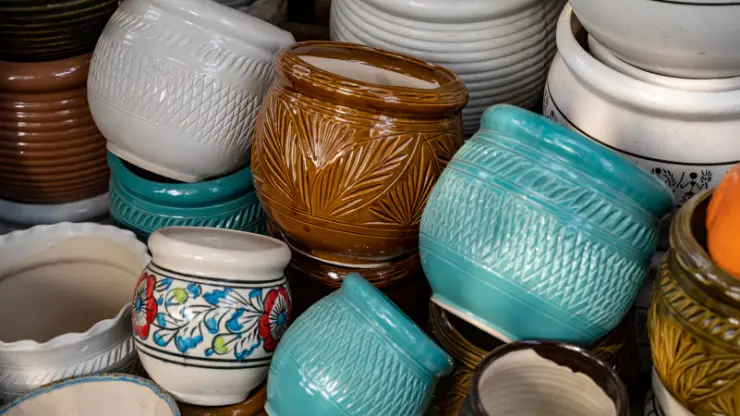
How to Fix Kangaroo Paw Fern Leaves Turning Brown
In conclusion, there is one primary reason for kangaroo paw fern leaves turning brown. The plant is too dry – either from too much sunlight exposure, inconsistent watering, and/or poor quality potting soil that doesn’t retain moisture or drain well.
You can fix this issue easily enough. Just make sure to give your fern plenty of indirect sunlight from a north- or east-facing window, water consistently to keep the soil moist (but not wet), and make sure to use a good-quality potting soil that drains well and retains moisture.
Can ferns come back after browning?
Yes. As long as the entire plant hasn’t turned brown and died, ferns can come back after browning. Make the changes to increase water and reduce sunlight, plus ensure soil is well-draining. If there is any life left in your fern, it will come back. If it’s completely dead and brown, it might be too late.
Once you make the necessary changes, give your plant a few weeks to recover. It may drop the brown leaves that are already present. But if you’re doing things right, you shouldn’t see any more. An occasional brown leaf isn’t a big deal, but if you get multiple brown leaves at once – your fern is not happy and something needs to change.

